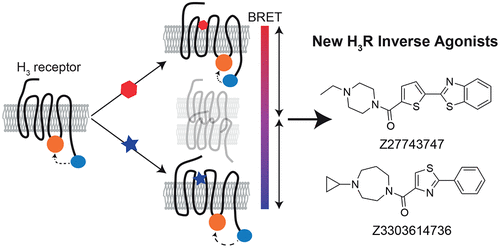Our official English website, www.x-mol.net, welcomes your
feedback! (Note: you will need to create a separate account there.)
Development of a Conformational Histamine H3 Receptor Biosensor for the Synchronous Screening of Agonists and Inverse Agonists.
ACS Sensors ( IF 8.2 ) Pub Date : 2020-05-13 , DOI: 10.1021/acssensors.0c00397 Hannes Schihada 1, 2 , Xiaoyuan Ma 3 , Ulrike Zabel 2 , Henry F Vischer 3 , Gunnar Schulte 1 , Rob Leurs 3 , Steffen Pockes 4 , Martin J Lohse 2, 5, 6
ACS Sensors ( IF 8.2 ) Pub Date : 2020-05-13 , DOI: 10.1021/acssensors.0c00397 Hannes Schihada 1, 2 , Xiaoyuan Ma 3 , Ulrike Zabel 2 , Henry F Vischer 3 , Gunnar Schulte 1 , Rob Leurs 3 , Steffen Pockes 4 , Martin J Lohse 2, 5, 6
Affiliation

|
The histamine H3 receptor (H3R) represents a highly attractive drug target for the treatment of various central nervous system disorders, but the discovery of novel H3R targeting compounds relies on the assessment of highly amplified intracellular signaling events that do not only reflect H3R modulation and carry the risk of high false-positive and -negative screening rates. To address these limitations, we designed an intramolecular H3R biosensor based on the principle of bioluminescence resonance energy transfer (BRET) that reports the receptor’s real-time conformational dynamics and provides an advanced tool to screen for both H3R agonists and inverse agonists in a live cell screening-compatible assay format. This conformational G-protein-coupled receptor (GPCR) sensor allowed us to characterize the pharmacological properties of known and new H3 receptor ligands with unprecedented accuracy. Interestingly, we found that one newly developed H3 receptor ligand possesses even stronger inverse agonistic activity than reference H3R inverse agonists including the current gold standard pitolisant. Taken together, we describe here the design and validation of the first screening-compatible H3R conformational biosensor that will aid in the discovery of novel H3R ligands and can be employed to gain deeper insights into the (in-)activation mechanism of this highly attractive drug target.
中文翻译:

构象组胺H3受体生物传感器的开发,用于激动剂和逆激动剂的同步筛选。
组胺H 3受体(H 3 R)代表了用于治疗各种中枢神经系统疾病的极具吸引力的药物靶标,但是新型靶向H 3 R的化合物的发现依赖于高度扩增的细胞内信号转导事件的评估,这不仅反映H 3 R调制,并具有高假阳性和阴性筛查率的风险。为了解决这些局限性,我们基于生物发光共振能量转移(BRET)原理设计了分子内H 3 R生物传感器,该传感器报告受体的实时构象动力学,并提供了一种用于筛选H 3的先进工具活细胞筛选兼容测定形式的R激动剂和反向激动剂。这种构象的G蛋白偶联受体(GPCR)传感器使我们能够以前所未有的准确性表征已知和新的H 3受体配体的药理特性。有趣的是,我们发现一种新开发的H 3受体配体具有比参考H 3 R反向激动剂(包括当前的金标准pitolisant)更强的反向激动活性。两者合计,我们在这里描述了第一个筛选兼容的H 3 R构象生物传感器的设计和验证,这将有助于发现新型H 3R配体可以用于深入了解这种高度吸引人的药物靶标的(激活)机制。
更新日期:2020-06-26
中文翻译:

构象组胺H3受体生物传感器的开发,用于激动剂和逆激动剂的同步筛选。
组胺H 3受体(H 3 R)代表了用于治疗各种中枢神经系统疾病的极具吸引力的药物靶标,但是新型靶向H 3 R的化合物的发现依赖于高度扩增的细胞内信号转导事件的评估,这不仅反映H 3 R调制,并具有高假阳性和阴性筛查率的风险。为了解决这些局限性,我们基于生物发光共振能量转移(BRET)原理设计了分子内H 3 R生物传感器,该传感器报告受体的实时构象动力学,并提供了一种用于筛选H 3的先进工具活细胞筛选兼容测定形式的R激动剂和反向激动剂。这种构象的G蛋白偶联受体(GPCR)传感器使我们能够以前所未有的准确性表征已知和新的H 3受体配体的药理特性。有趣的是,我们发现一种新开发的H 3受体配体具有比参考H 3 R反向激动剂(包括当前的金标准pitolisant)更强的反向激动活性。两者合计,我们在这里描述了第一个筛选兼容的H 3 R构象生物传感器的设计和验证,这将有助于发现新型H 3R配体可以用于深入了解这种高度吸引人的药物靶标的(激活)机制。











































 京公网安备 11010802027423号
京公网安备 11010802027423号